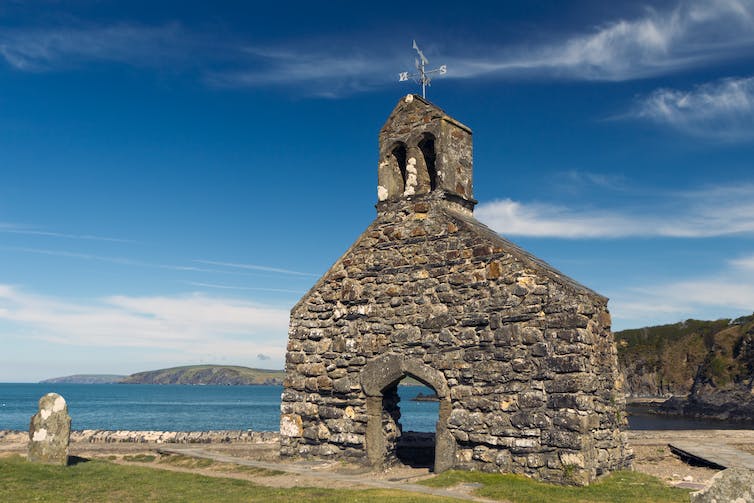The Royal Charter was shipwrecked at Porth Alerth close to Moelfre on Anglesey. John Oxley Library, State Library of Queensland
You can learn this text in Welsh.
In British climate historical past, one storm stands out as a catalyst for change – the Royal Charter Storm of 1859. This devastating tempest off the west coast of Britain performed a pivotal function within the founding of the delivery forecast and has had a permanent impression on climate forecasting within the UK and past.
Winds gusted at 100 miles per hour between October 25 and 26 that yr – greater than any beforehand recorded within the Mersey, in north-west England. And it’s thought of to be essentially the most extreme Irish Sea storm of the nineteenth century. More than 800 lives have been misplaced and the storm sank or badly broken greater than 200 ships. But it additionally paved the way in which for the creation of the delivery forecast.
The storm is known as after essentially the most well-known of the ships misplaced to the waves, a steam and crusing ship referred to as the Royal Charter. After a two-month journey from Melbourne in Australia, the Royal Charter was heading in the direction of Liverpool with its priceless cargo of gold. The ship was caught within the full fury of the storm off the coast of Anglesey, Wales.
Despite the crew’s valiant efforts to anchor the ship and minimize its sails, the Royal Charter was pushed onto the rocks within the early hours of October 26. With the assistance of villagers onshore, they succeeded in saving round 40 passengers. Other passengers had tried to swim to shore however have been weighed down by the gold of their pockets and drowned. The ship finally cut up in two and the waves claimed the lives of greater than 450 passengers and crew members, together with all the ladies and kids aboard.
The tragic lack of life and property made the storm headline information. It even got here to the eye of Charles Dickens, who was working as a journalist in London on the time and visited the location of the wreck quickly after the storm.
The delivery forecast and the Met Office
Weather observations had been collected from across the British coast since 1854 by part of the UK Met Office identified then because the Meteorological Department of the Board of Trade. The Royal Charter Storm, nevertheless, highlighted a necessity for extra correct climate forecasting and a nationwide storm warning system.

Vice Admiral Robert Fitzroy.
Wikimedia Commons
Vice Admiral Robert Fitzroy, founding father of the Met Office, had been lobbying for the creation of such a storm warning system because the summer season of 1859. Following the Royal Charter storm, Fitzroy was in a position to show that it might have been predicted.
In December of that yr, the brand new storm warning system was permitted and the primary warning was issued in February 1861. This was delivered by telegraph to harbour cities, who then hoisted cones and drums on a mast to warn vessels in harbours and alongside the coast of the incoming storm.
The UK’s storm warning service – which later turned generally known as the delivery forecast – is the longest working nationwide forecasting service on this planet. Today, the Met Office offers the delivery forecast on behalf of the Maritime and Coastguard Agency, and points a forecast 4 instances a day for the 31 areas of sea across the British Isles.
An enduring legacy
In addition to its meteorological legacy, the consequences of the storm can nonetheless be seen across the Welsh shoreline to this present day. On Anglesey, the graves of those that died within the wreck could be discovered in lots of church buildings alongside the coast. Gold nuggets have additionally washed ashore lately.
Further south, in Cwmyreglwys, Pembrokeshire, stand the stays of Saint Brynach’s church, which was partially destroyed by the storm.

The ruins of St Brynach’s Church in Cwmyreglwys, Pembrokeshire.
Dr Morley Read/Shutterstock
Since 1859, the Met Office has made important strides within the area of meteorology. In August 1861, the primary public climate forecast was printed in The Times, then broadcast on the radio in 1922 and was finally seen on tv for the primary time in 1936.
Step by step, the Met Office has pioneered new applied sciences by launching the world’s first meteorological satellite tv for pc in 1960 and utilizing the primary forecast by a pc in 1965. It has continued to put money into state-of-the-art supercomputers to enhance extreme climate and local weather forecasting since then.
Today, the Met Office is a globally recognised authority in meteorology and local weather science. Its experience is invaluable for quite a few sectors, from aviation and agriculture to emergency companies and infrastructure planning. The Met Office is now answerable for offering the National Severe Weather Warning Service, which incorporates warnings for wind, rain, thunderstorms, lightning, ice, fog, snow and excessive warmth.
Through the Met Office’s dedication to scientific analysis and correct forecasting, the UK and the world have benefited from improved climate predictions and elevated preparedness for excessive climate occasions. The legacy of the Royal Charter Storm lives on within the Met Office’s ongoing mission to offer important climate and local weather companies, safeguarding lives and livelihoods in an ever-changing local weather.
![]()
Cerys Jones has beforehand obtained funding from the AHRC, EU's Ireland-Wales Programme 2014-2020, and the Coleg Cymraeg Cenedlaethol.
